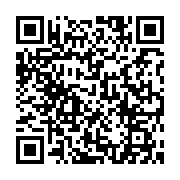Offline AI Binocular 3D Vision Recognition Sensor (Face / Palm Vein / QR Code) - แท้ DFRobot
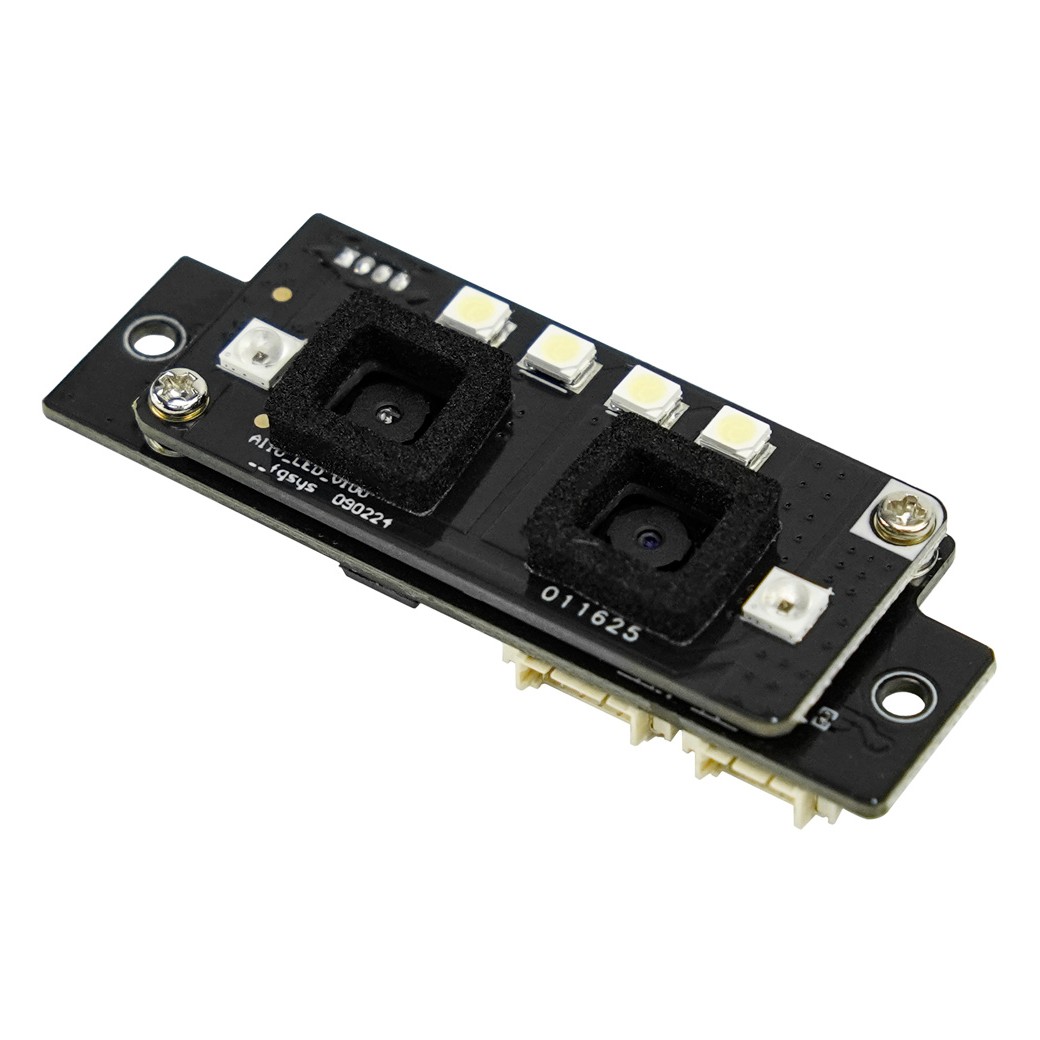


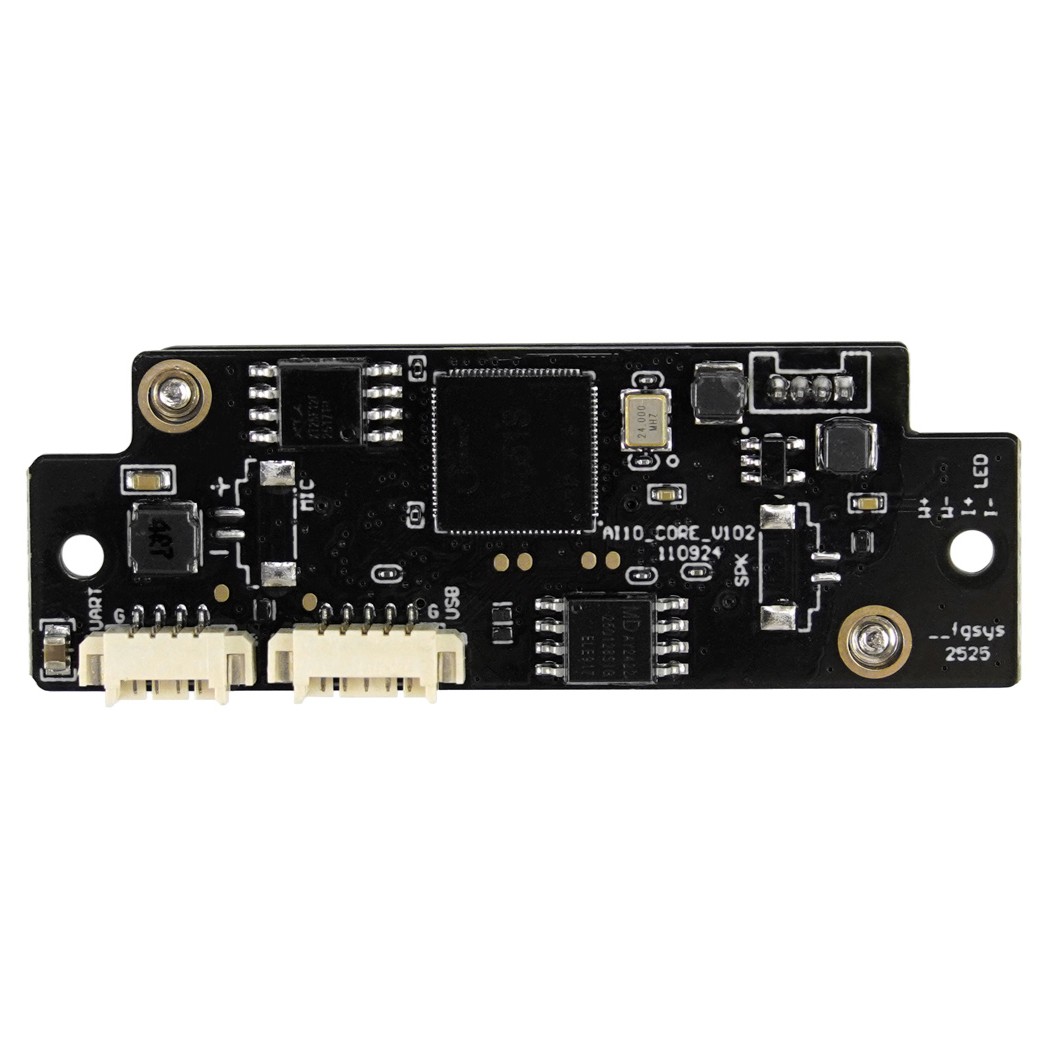
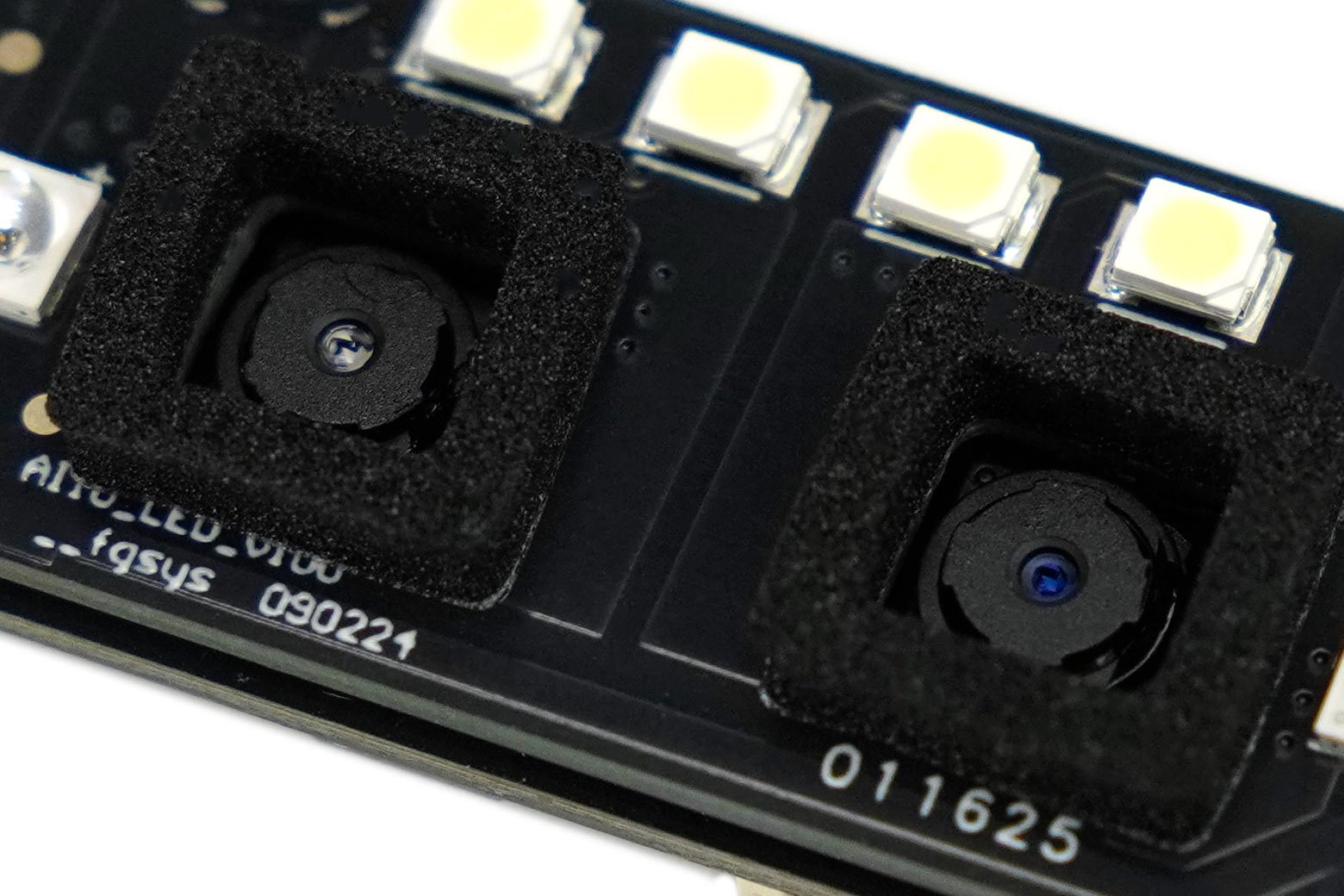
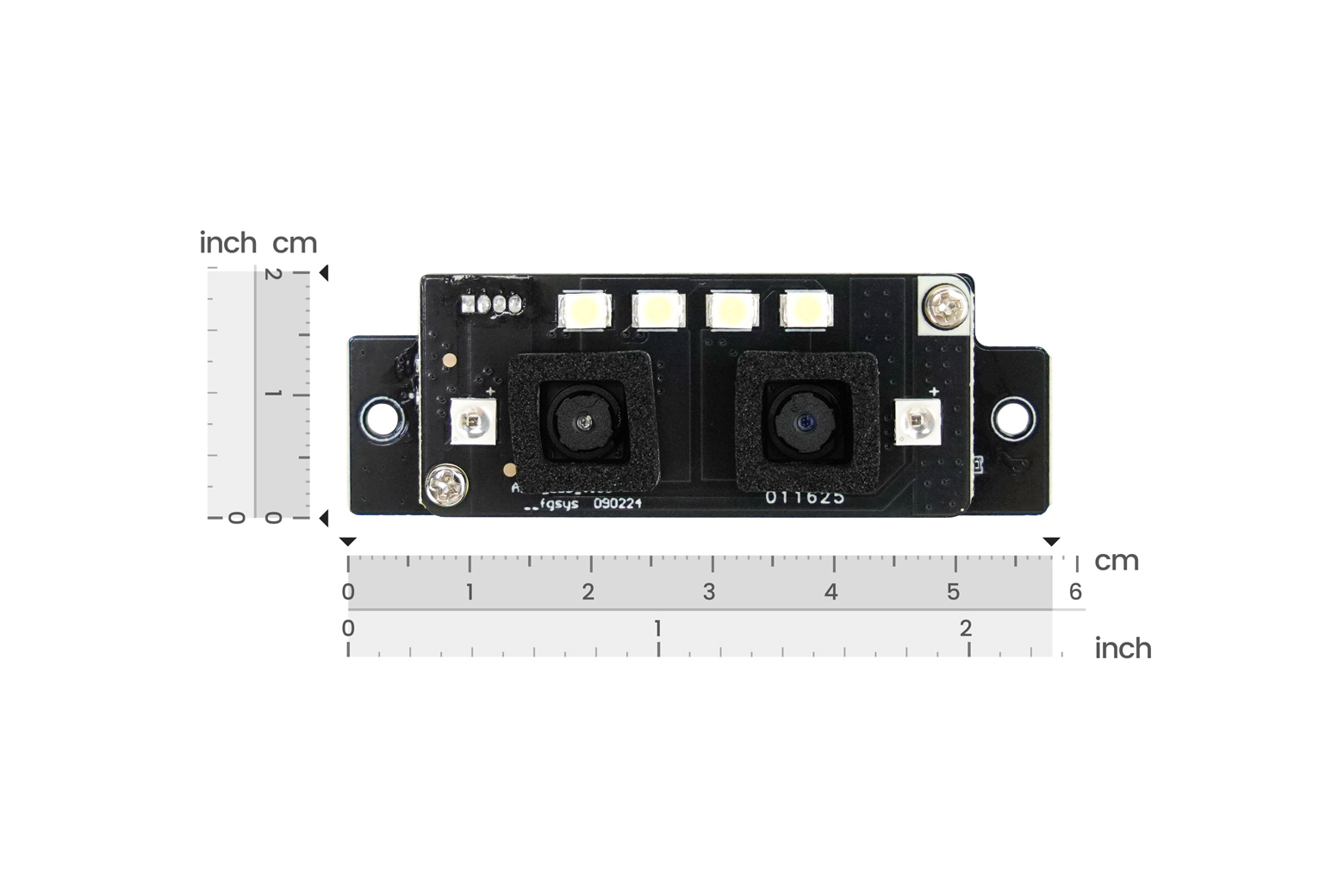
| รหัสสินค้า | SG30281 |
| หมวดหมู่ | โมดูลวัดสี กล้องและการมองเห็น Camera / Color / Vision |
| ราคา | 2,385.00 บาท |
| สถานะสินค้า | พร้อมส่ง |
| จำนวน | ชิ้น |
รายละเอียดสินค้า
อุปกรณ์ชิ้นนี้ถูกออกแบบมาเพื่อการยืนยันตัวตนที่ทั้งปลอดภัยและสะดวกสบาย ภายในรวมเทคโนโลยี 3 แบบไว้ในตัวเดียว ทั้ง การจดจำใบหน้า การสแกนเส้นเลือดฝ่ามือ และ การอ่าน QR Code จึงตอบโจทย์ได้ทั้งการใช้งานส่วนบุคคลและระบบองค์กร จุดเด่นที่สุดคือระบบ 3D Liveness Detection ที่สามารถแยกแยะได้ว่าผู้ใช้เป็นบุคคลจริง ไม่ใช่ภาพถ่ายหรือวิดีโอ ช่วยลดความเสี่ยงจากการปลอมแปลง นอกจากนี้ยังประมวลผล AI ทั้งหมดภายในตัวเองแบบออฟไลน์ ไม่ต้องพึ่งเซิร์ฟเวอร์หรือคอมพิวเตอร์เสริม ทำให้ข้อมูลปลอดภัยและตอบสนองได้อย่างรวดเร็ว แม้จะมีขนาดกะทัดรัด แต่ก็รองรับผู้ใช้งานได้มากถึง 1,000 คน และสามารถทำงานได้ทั้งในที่มืดหรือกลางแจ้ง การติดตั้งก็ไม่ซับซ้อน เพียงเชื่อมต่อผ่าน UART หรือ USB ก็พร้อมใช้งานร่วมกับระบบที่มีอยู่แล้วทันที เหมาะอย่างยิ่งสำหรับการนำไปใช้ใน ระบบควบคุมการเข้าออก สมาร์ทโฮม ไปจนถึงเครื่องบริการอัตโนมัติ ที่ต้องการทั้งความปลอดภัยสูงและการใช้งานที่ง่ายดายในตัวเดียว
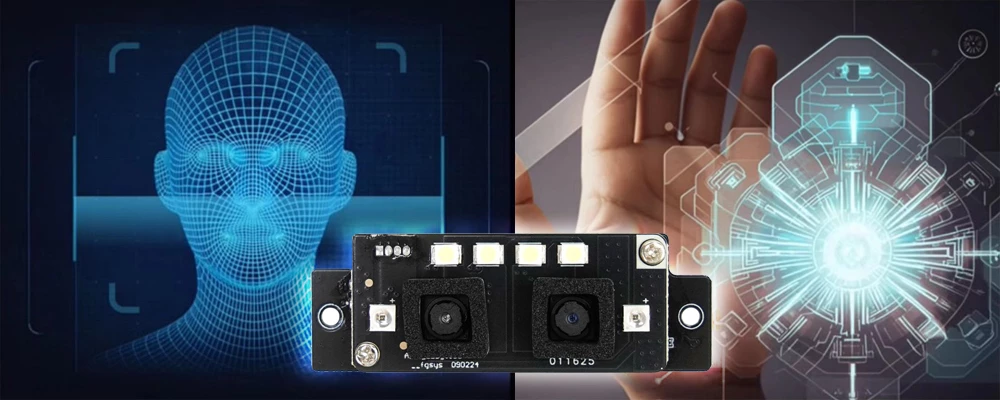
Security is paramount in authentication systems. This face recognition sensor employs a binocular camera system (RGB + Infrared) to capture 3D depth information, enabling a sophisticated liveness detection algorithm. This technology effectively distinguishes a live person from a 2D representation, providing robust protection against spoofing attempts using photos or videos. With a Face Recognition False Acceptance Rate (FAR) as low as 0.001%, the module delivers a level of security suitable for critical access control applications.
The AI binocular vision sensor offers unparalleled flexibility by combining three distinct recognition methods. The deep learning-based face recognition provides fast, contactless access. For enhanced security, the palm vein and palm print recognition algorithm identifies the unique subcutaneous vein patterns, a biometric marker that is extremely difficult to replicate. Finally, the integrated QR code decoding offers a convenient solution for granting temporary access, processing payments, or device pairing, making the sensor adaptable to a wide range of operational requirements.
Equipped with a dedicated System-on-Chip (SoC) featuring a 0.5 TOPS Neural Processing Unit (NPU), the AI vision camera handles all complex AI algorithms internally. This "edge computing" design means it requires zero computational resources from the host device, allowing it to be controlled by any microcontroller, including basic models like an Arduino Uno. All user data, including 1,000 face and 1,000 palm vein templates, is stored and processed locally, ensuring system performance, data privacy, and functionality even without a network connection.
Designed for ease of implementation, the binocular camera communicates recognition results through a simple UART serial protocol, making it straightforward to integrate into both new and existing product designs. Furthermore, the USB interface supports the UVC (USB Video Class) protocol, allowing the module to stream video like a standard webcam. This dual functionality is invaluable for applications requiring video feeds for monitoring, visual confirmation, or building video intercom systems.
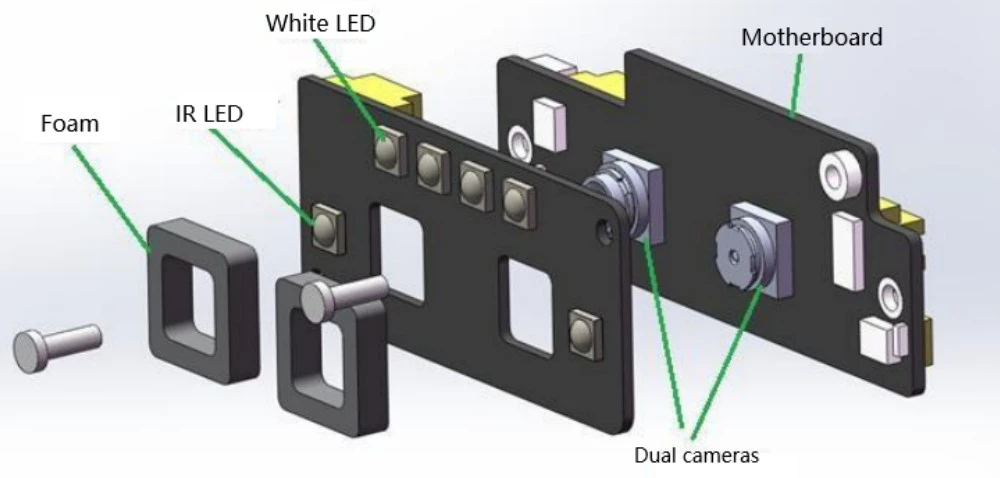
Figure: AI binocular vision recognition sensor hardware composition diagram
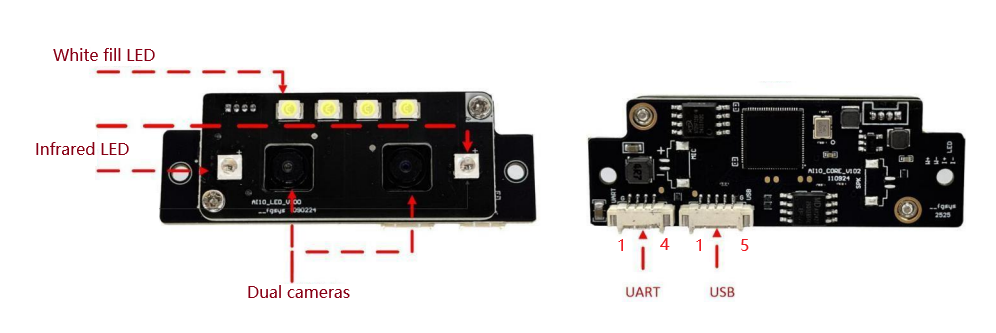
Features
- Binocular 3D liveness detection resists spoofing via photos/videos
- Neural network-based algorithms: face recognition, palm vein recognition, QR code decoding
- Local storage: 1,000 faces + 1,000 palm vein templates
- Operates in complete darkness and non-direct sunlight outdoors
- Zero host-computation requirement; all AI processing occurs offline on-module
Applications
- Smart home systems
- Smart door locks
- Self-service retail payment terminals
- 3D face/palm vein payment systems
- Palm vein authentication systems

Specification
- SoC: Arm CPU@900MHz, NPU@0.5TOPS, RISC-V@600MHz
- DDR2: 64MB
- Flash: 32MB
- Cameras: Dual 1/5” CMOS, 2MP, dual MIPI interfaces
- Lens: FOV: 83° diagonal; optimal focus: 60cm
- LED: IR@850nm, RGB@650nm (90° illumination)
- USB: UVC video transmission (expandable to UAC); MJPEG output (H.264/YUY2 expandable)
- Communication: UART@115200 baud
- Supply voltage: 5-12V
- Operating current: 320-330mA@8V
- Standby current: 120–130mA (auto-detection mode)
- Shutdown current: 0µA (non-auto-detection mode)
- Operating temperature: -20°C to +60°C
- Storage temperature: -30°C to +70°C
- Humidity: 10–93% RH (non-condensing)
- Audio I/O: Expandable (speaker/microphone)
- Boot time: 900ms–2.5s (varies with stored user count)
- User capacity: 1,000 faces; 1,000 palm veins
- Algorithms: Binocular liveness detection, deep learning face recognition, palm vein recognition, QR code recognition
- Liveness metrics:
- FAR (False Acceptance Rate) ≤1%
- FRR (False Rejection Rate) ≤1%
- Face recognition:
- Pass rate: 98.85%
- FAR: 0.001%
- Recognition angle: ±20° pitch/yaw; supports multi-angle enrollment
- Detection range: Face: 30–120 cm, palm vein / QR code: 15cm
- Dimensions: 57.8×20×10.12mm
Documents
Shipping List
- AI Binocular Vision Recognition Sensor (Face & Palm Vein & QR Code) ×1
- 1.25mm 4-pin to Dupont female connector cable ×1
- USB data cable ×1
Tutorial
Requirements
- Hardware
- Arduino UNO R3 x 1
- Gravity: IO Expansion Shield for Arduino V7.1 x1
- AI Binocular Vision Recognition Sensor(Face & Palm Vein & QR Code) x1
- 1.25mm 4-pin to Dupont female connector cable ×1
- USB data cable ×1
- Software
- Arduino IDE
- Download DFRobot_AI10 library
Connection Diagram
The PC USB interface has low power, so it is recommended to use a 5V USB adapter for power supply, which will make the recognition more sensitive.
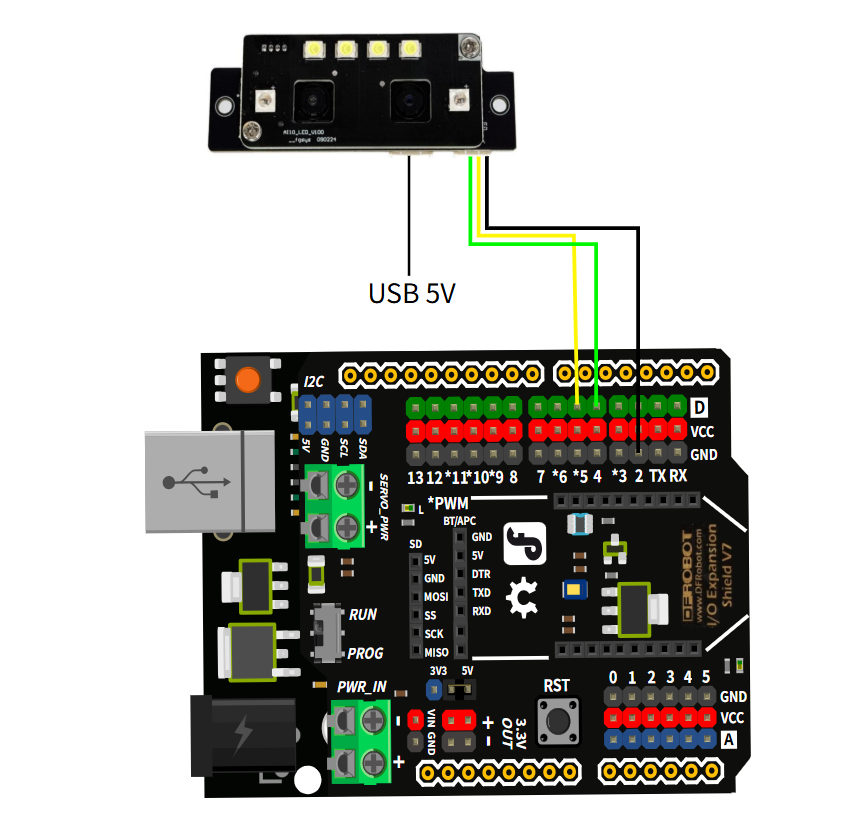
Registering face & palm print Sample Code
When registering face or palm print, you need to fix the AI visual sensor and pay attention to the recognition distance, 30-120cm for face, 15cm for vein palm print, and 15cm for QR code. Only one face or palm print is registered each time. If you need to register multiple, you can press the reset button of the UNO R3 development board to register other faces or palm prints again.
/*!
* @file SingleRegisteredUser.ino
* @brief This is an example of using the DFRobot_AI10 library to enroll a single registered user.
* @copyright Copyright (c) 2025 DFRobot Co.Ltd (http://www.dfrobot.com)
* @license The MIT License (MIT)
* @author [jiali](zhixinliu@dfrobot.com)
* @version V1.0
* @date 2025-07-14
* @url https://github.com/DFRobot/DFRobot_AI10
*/
#include "DFRobot_AI10.h"
/* ---------------------------------------------------------------------------------------------------------------------
* board | MCU | Leonardo/Mega2560/M0 | UNO | ESP8266 | ESP32 | microbit | m0 |
* VCC | 3.3V/5V | VCC | VCC | VCC | VCC | X | vcc |
* GND | GND | GND | GND | GND | GND | X | gnd |
* RX | TX | Serial1 TX1 | 5 | 5/D6 | 26/D3 | X | tx1 |
* TX | RX | Serial1 RX1 | 4 | 4/D7 | 25/D2 | X | rx1 |
* ----------------------------------------------------------------------------------------------------------------------*/
/* Baud rate cannot be changed , it is 115200 */
#if defined(ARDUINO_AVR_UNO) || defined(ESP8266)
SoftwareSerial mySerial(4, 5);
DFRobot_AI10_UART recognize(&mySerial ,115200);
#elif defined(ESP32)
DFRobot_AI10_UART recognize(&Serial1,/*rxD2*/25,/*txD3*/26);
#else
DFRobot_AI10_UART recognize(&Serial1 ,115200);
#endif
void setup() {
Serial.begin(115200);
while (!Serial);
while(!recognize.begin()){
Serial.println("NO Deivces !");
delay(1000);
}
Serial.println("Device connected!");
Serial.println("Start to enroll a user...");
//User enroll result anc info
sUserData_t udata;
/*
*admin permission is required to register a user. eNormal:average person ,eAdmin: administrator
*userName registered user name, the length is 32 bytes at most
*timeout is the time to wait for the recognition result, the range is 3-20 seconds
*/
udata = recognize.enrollUser(/*admin*/eNormal,/*userName*/"User1",/*timeout*/ 5);
//Check if the registration is successful, if successful, print the user information
if(udata.result == eSuccess){
Serial.println("User enrolled successfully!");
Serial.print("UID: ");
Serial.println(udata.UID);
Serial.print("User name: ");
Serial.println(udata.userName);
Serial.print("Admin permission: ");
Serial.println(udata.admin == eNormal ? "Normal":"Admin");
Serial.print("User enrolled type: ");
Serial.println(udata.type == eFace ? "Face":"Palm");
}else if (udata.result == eFailedFaceEnrolled){
Serial.println("Failed to enroll user, user already enrolled!");
}else{
Serial.println("Failed to enroll user!");
}
}
void loop() {
delay(100);
}
Expected Results
Register through the reset button of the UNO R3 development board. Each reset can register a face or palm print once. Each registration time is 5S. ID 1-1000 is face, and 1001-2000 is vein palm print.
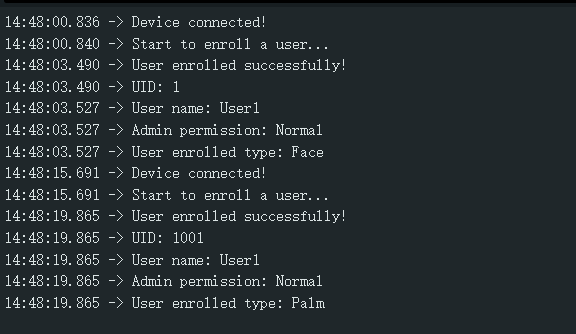
Continuously identify faces, palm prints, and QR codes Sample Code
Continuously identify faces, palm prints, and QR codes, and print the corresponding information through the serial port monitor. If it cannot be recognized, you can adjust the distance or posture slightly and keep it still.
/*!
* @file continuousRecognition.ino
* @brief This is an example of using the DFRobot_AI10 library to recognize human faces and QR codes in real-time.
* @copyright Copyright (c) 2025 DFRobot Co.Ltd (http://www.dfrobot.com)
* @license The MIT License (MIT)
* @author [jiali](zhixinliu@dfrobot.com)
* @version V1.0
* @date 2025-07-14
* @url https://github.com/DFRobot/DFRobot_AI10
*/
#include "DFRobot_AI10.h"
/* ---------------------------------------------------------------------------------------------------------------------
* board | MCU | Leonardo/Mega2560/M0 | UNO | ESP8266 | ESP32 | microbit | m0 |
* VCC | 3.3V/5V | VCC | VCC | VCC | VCC | X | vcc |
* GND | GND | GND | GND | GND | GND | X | gnd |
* RX | TX | Serial1 TX1 | 5 | 5/D6 | 26/D3 | X | tx1 |
* TX | RX | Serial1 RX1 | 4 | 4/D7 | 25/D2 | X | rx1 |
* ----------------------------------------------------------------------------------------------------------------------*/
/* Baud rate cannot be changed , it is 115200 */
#if defined(ARDUINO_AVR_UNO) || defined(ESP8266)
SoftwareSerial mySerial(4, 5);
DFRobot_AI10_UART recognize(&mySerial ,115200);
#elif defined(ESP32)
DFRobot_AI10_UART recognize(&Serial1,/*rxD2*/25,/*txD3*/26);
#else
DFRobot_AI10_UART recognize(&Serial1 ,115200);
#endif
void setup() {
Serial.begin(115200);
while (!Serial);
while(!recognize.begin()){
Serial.println("NO Deivces !");
delay(1000);
}
Serial.println("Device connected!");
//Enable face frame
if(recognize.enableFaceFrame()){
Serial.println("Face frame enabled!");
}
}
void loop() {
//Continuous recognition result
sRecognitionData_t recDat;
/* When a human face is detected, the system automatically starts the recognition process.After the person moves away for
x seconds, the recognition stops and the module continues with low-power face detection.the range is 3-20s.
*/
recDat = recognize.startContinuousFaceRecognition(/*timeout*/5);
//Print the recognition result
if(recDat.result == eSuccess){
Serial.println("Recognition successful!");
Serial.print("Recognition type: ");
if(recDat.type == eQR){
Serial.println("QR code");
Serial.print("QR code data: ");
Serial.println(recDat.QRDdata);
}else{
Serial.println(recDat.type == eFace ? "Face" : "Palm");
Serial.print("User ID: ");
Serial.println(recDat.userData.UID);
Serial.print("User Name: ");
Serial.println(recDat.userData.userName);
Serial.print("Admin Permission: ");
Serial.println(recDat.userData.admin == eAdmin ? "Admin" : "Normal");
}
}else{
Serial.println("Recognize...");
}
}
Expected Results
Continuously identify the detected faces, palm prints, and QR codes, and print the corresponding information through the serial port monitor.
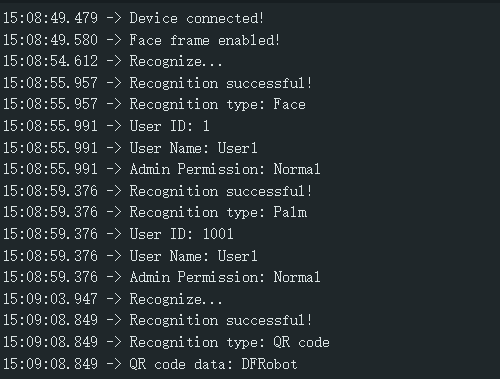
User statistics & user deletion Sample Code
Input command: AT+GETUSERS, query all user numbers and IDs
Input command: AT+DELUSER=1, delete the specified user ID1, 1 can be replaced by other user IDs
Input command: AT+DELALLUSERS, delete all registered users
/*!
* @file operateUserData.ino
* @brief This is an example of how to use the DFRobot_AI10 library to operate user data
* @copyright Copyright (c) 2025 DFRobot Co.Ltd (http://www.dfrobot.com)
* @license The MIT License (MIT)
* @author [jiali](zhixinliu@dfrobot.com)
* @version V1.0
* @date 2025-07-14
* @url https://github.com/DFRobot/DFRobot_AI10
*/
#include "DFRobot_AI10.h"
/* ---------------------------------------------------------------------------------------------------------------------
* board | MCU | Leonardo/Mega2560/M0 | UNO | ESP8266 | ESP32 | microbit | m0 |
* VCC | 3.3V/5V | VCC | VCC | VCC | VCC | X | vcc |
* GND | GND | GND | GND | GND | GND | X | gnd |
* RX | TX | Serial1 TX1 | 5 | 5/D6 | 26/D3 | X | tx1 |
* TX | RX | Serial1 RX1 | 4 | 4/D7 | 25/D2 | X | rx1 |
* ----------------------------------------------------------------------------------------------------------------------*/
/* Baud rate cannot be changed , it is 115200 */
#if defined(ARDUINO_AVR_UNO) || defined(ESP8266)
SoftwareSerial mySerial(4, 5);
DFRobot_AI10_UART recognize(&mySerial ,115200);
#elif defined(ESP32)
DFRobot_AI10_UART recognize(&Serial1,/*rxD2*/25,/*txD3*/26);
#else
DFRobot_AI10_UART recognize(&Serial1 ,115200);
#endif
void setup() {
Serial.begin(115200);
while (!Serial);
while(!recognize.begin()){
Serial.println("NO Deivces !");
delay(1000);
}
Serial.println("Device connected!");
Serial.println("AI10 An example of AT command control");
Serial.println("-----------------------------");
Serial.println("Available commands:");
Serial.println("AT+GETUSERS # Get all user information");
Serial.println("AT+DELUSER=ID # Delete the specified user (e.g. AT+DELUSER=0x1001)");
Serial.println("AT+DELALLUSERS # Delete all users");
Serial.println("-----------------------------");
Serial.println("Note: When sending, end with \'\\n\'. Please pay attention to line breaks!");
Serial.println("-----------------------------");
}
void loop() {
sAllUserID_t alluser;
int i;
if (Serial.available()) {
// Read the command from the serial port
String command = Serial.readStringUntil('\n');
command.trim();
if (command.startsWith("AT+GETUSERS")){
/* Get all user information*/
alluser = recognize.getAllUserIDs();
if(alluser.result == eSuccess){
Serial.print("User number:");
Serial.println(alluser.userNum);
if(alluser.userNum != 0){
Serial.print("User IDs:");
for(i=0;i<alluser.userNum;i++){
Serial.print(alluser.UIDS[i]);
Serial.print(" ");
}
Serial.println();
}
}
Serial.println("OK");
} else if (command.startsWith("AT+DELUSER=")) {
uint16_t ID = command.substring(11).toInt();
/* Delete the user with the specified ID*/
if(recognize.deleteUser(ID)){
Serial.println("successfully deleted!");
}
Serial.println("OK");
} else if (command.endsWith("AT+DELALLUSERS")) {
/* Delete all users */
if(recognize.deleteAllUser()){
Serial.println("successfully deleted!");
}
Serial.println("OK");
} else {
Serial.println("The command is incorrect!");
}
}
}
Expected Results
Enter the corresponding command to query the number of users, delete users, etc.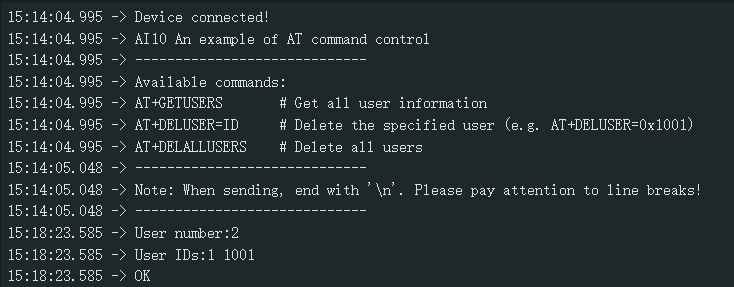





วิธีการชำระเงิน
ชำระเงินค่าสินค้าโดยการโอนเงินเข้าบัญชีธนาคาร KBANK, SCB, BBL,TMB
กรุณาเก็บหลักฐานการโอนเงินของท่านไว้เพื่อแจ้งการชำระเงินด้วยค่ะ
ท่านสามารถแจ้งการชำระเงินผ่านระบบอัตโนมัติได้โดย Click Link ข้างล่างค่ะ
https://www.arduitronics.com/informpayment
ชำระเงินผ่านธนาคาร
สินค้าที่เกี่ยวข้อง
SEARCH
CATEGORY
CONTACT US
Join เป็นสมาชิกร้านค้า
STATISTICS
| หน้าที่เข้าชม | 15,491,918 ครั้ง |
| ผู้ชมทั้งหมด | 5,994,996 ครั้ง |
| เปิดร้าน | 21 พ.ค. 2556 |
| ร้านค้าอัพเดท | 19 พ.ย. 2568 |
TRACK&TRACE
MEMBER
- ระดับ{{userdata.dropship_level_name}}
- ไปหน้าหลักตัวแทน
- ทั้งหมด {{(order_nums && order_nums.all)?'('+order_nums.all+')':''}}
- รอการชำระเงิน {{(order_nums && order_nums.wait_payment)?'('+order_nums.wait_payment+')':''}}
- รอตรวจสอบยอดเงิน {{(order_nums && order_nums.wait_payment_verify)?'('+order_nums.wait_payment_verify+')':''}}
- รอจัดส่งสินค้า {{(order_nums && order_nums.wait_send)?'('+order_nums.wait_send+')':''}}
- รอยืนยันได้รับสินค้า {{(order_nums && (order_nums.wait_receive || order_nums.wait_confirm))?'('+(order_nums.wait_receive+order_nums.wait_confirm)+')':''}}
- รอตรวจสอบข้อร้องเรียน {{(order_nums && order_nums.dispute)?'('+order_nums.dispute+')':''}}
- เรียบร้อยแล้ว {{(order_nums && order_nums.completed)?'('+order_nums.completed+')':''}}
- ทั้งหมด {{(order_nums && order_nums.all)?'('+order_nums.all+')':''}}
- รอการชำระเงิน {{(order_nums && order_nums.wait_payment)?'('+order_nums.wait_payment+')':''}}
- รอตรวจสอบยอดเงิน{{(order_nums && order_nums.wait_payment_verify)?'('+order_nums.wait_payment_verify+')':''}}
- รอจัดส่งสินค้า {{(order_nums && order_nums.wait_send)?'('+order_nums.wait_send+')':''}}
- ส่งสินค้าเรียบร้อยแล้ว {{(order_nums && order_nums.sent)?'('+order_nums.sent+')':''}}




